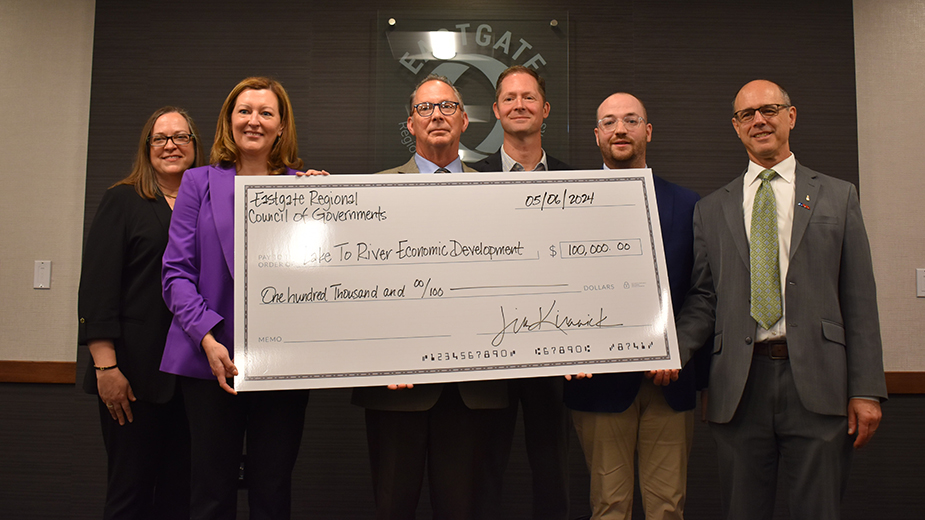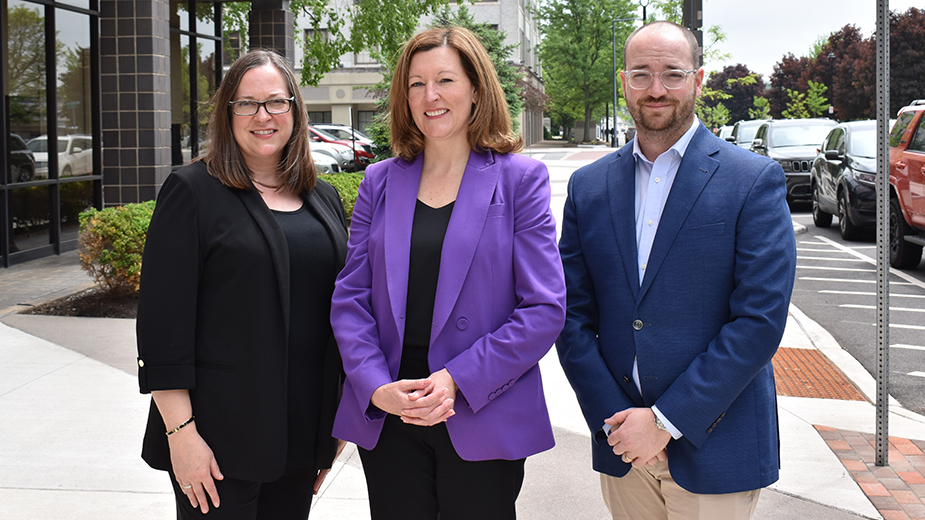YOUNGSTOWN, Ohio – So how did Alexa Sweeney Blackann end up as interim CEO of the region’s newest economic development entity?
Thank Youngstown State University’s former president.
“Jim Tressel nominated me,” she says. “He suggested that I had some extra time.”
Blackann, president of Sweeney Chevrolet Buick GMC before its sale to #1 Cochran in December 2022, had been among community leaders participating in discussions over several months that culminated in a St. Patrick’s Day 2023 meeting with Gov. Mike DeWine.
At that meeting, the group directly pitched the establishment of a new JobsOhio district that would cover Ashtabula, Columbiana, Mahoning and Trumbull counties. The group, which had been laying the groundwork for that meeting for about five months, elected to nominate Blackann “to try and get this off the ground,” she says.
“At Sweeney, we built a lot of relationships in the community,” Blackann said May 6 during an interview in Lake to River’s temporary offices in space leased from the Youngstown/Warren Regional Chamber. “This was an opportunity to continue that commitment to the community and leverage those relationships in new ways.”
The creation of Lake to River Economic Development, the seventh and final JobsOhio region, was announced by DeWine April 24 in Niles. Its four member counties previously were affiliated with the then 18-county Team NEO region.
Blackann credits the community support her family business had received over the decades as one of the factors that motivated her to join the initiative.
“I don’t think you can have a business for 100 years and four generations and not have an invested interest in making sure the community succeeds,” she remarks.
The Sweeney family dealerships had long-standing partnerships with organizations such as United Way, Smarts Community Art School and the YSU Foundation. “What if we could move that effort a little bit toward economic development? Could we raise more boats?” she thought.
Blackann, who is not taking a salary as interim CEO, now heads a seven-person organization that includes several former Regional Chamber employees, including Sarah Boyarko, vice president of economic development, and Mike McGiffin, vice president of engagement and investor relations.
“Alexa answered a very important call to selflessly lead this effort from fact-finding to launch,” McGiffin says. “I don’t know that anybody else could have done what she did. Alexa pulled together four counties to do that.”
Blackann deflects the praise. “It was a team effort,” she says.
‘A Sense of Need’
Boyarko served various roles at the Regional Chamber during her 18 years there, including 14 in economic development, 11 of which as head of that department. She most recently served as the chamber chief operating officer.
“There was an opportunity to take a promotion at the chamber in the operations side of things. So I was interested in that and wanted to take advantage of it,” she says. But the Lake to River opportunity “made me realize that my true passion is in economic development.”
According to McGiffin, who served as director of the Youngstown/Warren Regional Chamber foundation before joining Lake to River, there was a “sense of need” for Boyarko.
“It’s important that this region has immediate success, right? We want to illustrate that this was a good decision,” he says. “Sarah is the foremost authority on economic development in this community, and it made perfect sense for her to lead that effort for the four counties.”
These counties have “a long history of working together,” Boyarko says. “This will just make that a much more cohesive partnership, sending the same message with the same voice.”
Examples of the four-county partnerships include the recent joint application for Appalachian Community Grant Program funds and a collaboration between the Western Reserve Port Authority and Columbiana County Port Authority on development of an assisted living center last year.
“This community is pulling together over the last five years in a way that I haven’t seen in my 10 years working on behalf of this community,” McGiffin says.
Boyarko agrees.
“There’s a concerted effort for that long-term approach in supporting the business community,” she says.
“Our strategic location with our unparalleled infrastructure and all of our assets makes us an ideal destination for businesses looking to thrive, especially when you look at the lake-to-river corridor,” Penny Traina, executive director of the Columbiana County Port Authority, says.
Traina cites the region’s access to major transportation routes and its skilled workforce.
Competitive Assets
Traina says this region “offers everything companies need to succeed.”
The four Appalachian counties have many of the same needs though not necessarily the same demographics, she notes.
“The important thing is that when we connect each of our robust economic development departments, we’ll begin to see more things that we have in common. This way we’re already partnered together as we move forward,” Traina says.
Greg Myers, executive director of the Growth Partnership for Ashtabula County, concurs.
The partner counties have worked “for a long time on collaborative initiatives around targeted industry attraction, leveraging in our port assets, particularly with our partners in Columbiana County and leveraging our rail infrastructure connectivity with our partners in Trumbull and Mahoning,” Myers says.
“This is just an extension of the opportunities we’ve seen for a long time in trying to work together with what we believe are highly competitive assets in the marketplace for certain targeted industries that fit well within these four counties,” he continues. “They probably aren’t the best fits within the former region we were a part of just because of the heavy industrial nature of them.”
Blackann praises the team that has been assembled for Lake to River as “thoughtful” and “committed to this work,” people who are “truly invested in making the Valley better.”
That team also includes Matt Falter, hired as director of talent engagement; David Wilaj, director of project management; Jason Neal, director of site strategies; and Michelle Phillips, director of research.
“These are not people that don’t have experience and haven’t been involved in many successes as part of the economic development ecosystem,” Boyarko notes. The team already is managing a portfolio of $1.7 billion of pending investment at various stages, and she anticipates some of those projects closing in the near future.
Lake to River’s board is “committed to finding a proper CEO with economic development experience at some point,” though there is no set timetable for that search, Blackann says.
“I’m delighted to be where I am right now, filling this role to get this off the ground and learning from all these wonderful people that are experts in this work,” she says. Anyone interested in the job should “come out of the woodwork” to apply “because that is what is best for the community.

Financial Contributions
Blackann, Boyarko and McGiffin all declined to say how much money Lake to River will require to operate, but McGiffin acknowledges the Regional Chamber Foundation made a “large seed investment.” The financial commitment by JobsOhio represents the biggest investment in the local economic development system he says he’s seen during his career.
Other financial contributions included $400,000 each over a two-year period from Mahoning and Trumbull counties’ boards of commissioners. Among the contributions is $200,000 from the Cafaro Foundation and $100,000 from Eastgate Regional Council of Governments, which drew from the $2.5 million provided by General Motors following its closing of the Lordstown plant.
“As an economic development partner, we certainly recognize the abundance of opportunity and business attraction that exist and look forward with great anticipation to what lies ahead as we grow together as a region,” Jim Kinnick, Eastgate executive director, said at a May 6 check presentation.
As a new JobsOhio region, Lake to River has access to coaching and relationships that hadn’t been available to the member counties before, she says.
JobsOhio established its regional affiliates to emphasize the need for buy-in from local businesses, governments and other partners, McGiffin says. That means not just providing financial support but also brain power, supportive decisions and helping to open doors.
“Economic development is the ultimate team sport,” he says, sharing a sentiment voiced by Bill Koehler, Team NEO’s CEO.
“There needs to be success regularly, and we all have a firm belief that there will be. The reason this is happening is because of the successes of the recent past,” McGiffin says.
Metrics for evaluating Lake to River’s success will include job creation, capital investment, annual payroll and completed research requests, according to Boyarko. The organization’s progress will be shared in quarterly newsletters and the annual report.
“It’s important to everybody who lives within the region. It’s good to be engaged with this,” she says. “That’s partially where our passion comes from. We live here and we want the community to succeed.”
The intent is to create an economy that improves every year. McGiffin emphasizes the Lake to River team is running a marathon, not a sprint. The partners who already have invested in the organization financially or with their time, energy or intellect, have realistic expectations.
“They know it’s a long, long-term play. I don’t think anybody who is investing into economic development is here for just a year from now,” he says. “It’s about looking 10 years from now, 15 years from now, and seeing a completely different landscape.”
Pictured at top: Sarah Boyarko, Alexa Sweeney Blackann and Michael McGiffin are leading Lake to River team.
